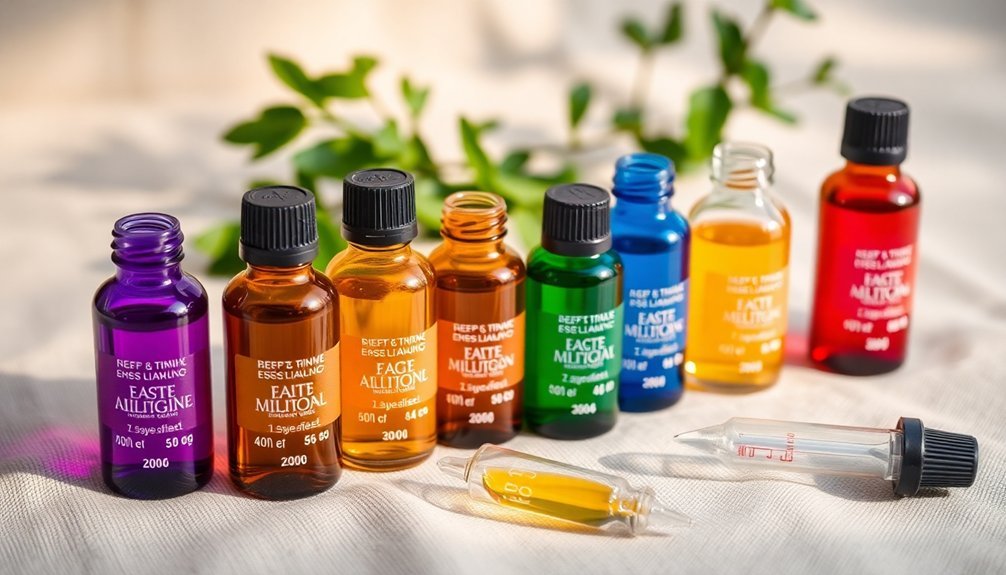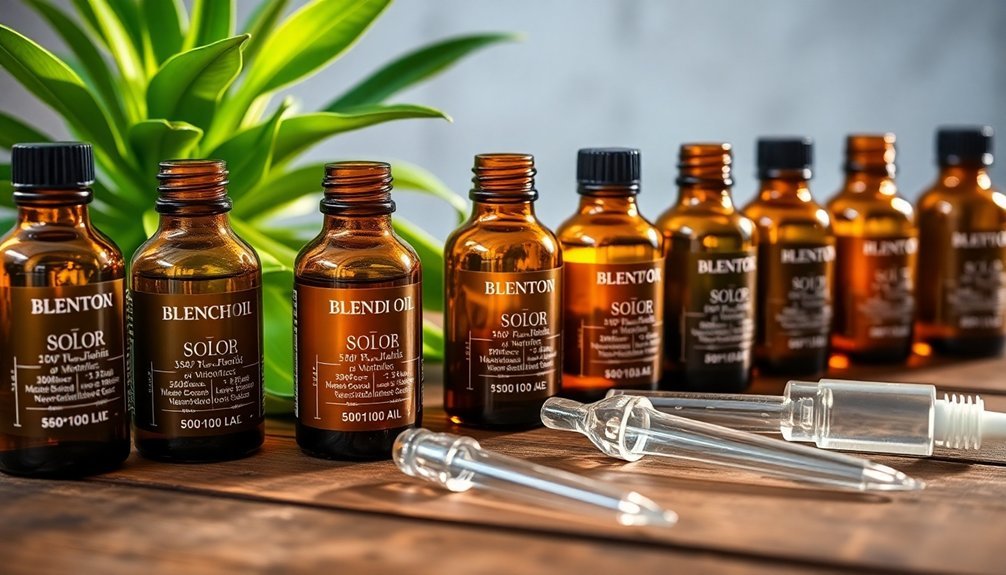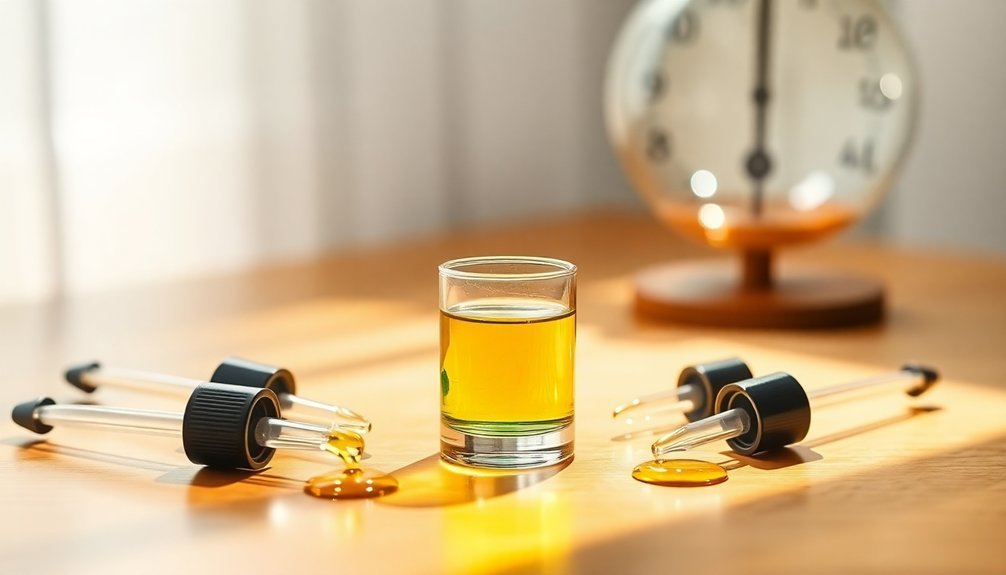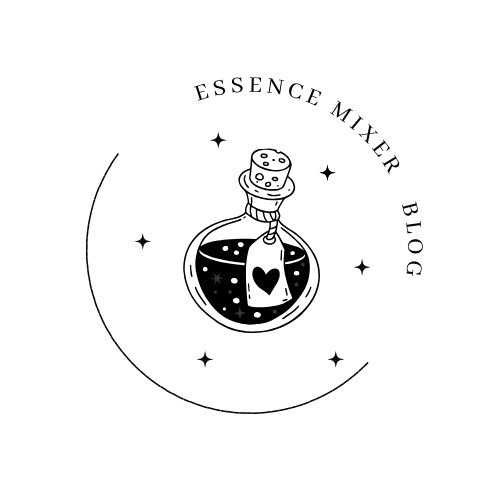Safe oil blending starts with understanding essential dilution ratios. You'll want to follow the 30-50-20 rule: 30% top notes, 50% middle notes, and 20% base notes. Stick to a 2% dilution (4 drops per 10mL carrier oil) for most applications, but reduce to 1% for sensitive skin and children. For aromatherapy blends, you can be more flexible with ratios. Let blends rest 24-48 hours before use. These fundamental guidelines open the door to mastering the art of essential oil blending.
Understanding Basic Dilution Percentages

When working with essential oils, understanding proper dilution percentages forms the foundation of safe and effective use.
You'll want to start with a 2% dilution for most applications, which means adding 4 drops to a 10 mL roller bottle or 12 drops to a 30 mL bottle.
For sensitive individuals or specific emotional needs, you'll benefit from a gentler 1% dilution, using just 2 drops per 10 mL of carrier oil.
While you can use up to 5% dilution in certain cases, it's not necessary for regular use, as lower concentrations work effectively for most purposes.
Remember to adjust your essential oil blends based on your personal health conditions and intended use.
You'll find that proper dilution percentages guarantee both safety and therapeutic benefits while preventing potential skin sensitivities.
Essential Oil Notes and Their Blending Proportions
To create balanced essential oil blends, you'll need to understand the three types of notes: top, middle, and base, which follow the 30-50-20 ratio rule for ideal results.
You'll achieve the most harmonious scents by combining 30% top notes for initial impact, 50% middle notes for the main body, and 20% base notes for lasting power.
When you're starting out, focus on selecting 3-4 oils across these categories and let your blend rest for 24-48 hours to develop its full aromatic potential.
Notes Within Blending Ratios
Understanding essential oil notes is fundamental to creating balanced blends that both smell wonderful and last. When you're mixing oils, remember that top notes evaporate quickly, middle notes form the heart of your blend, and base notes provide lasting depth.
You'll find success following these proven ratios:
- The 30-50-20 Rule: Use 30% top notes (like lemon), 50% middle notes (like lavender), and 20% base notes (like cedarwood)
- The Perfect Balance method: Equal parts of each note for straightforward blending
- The Bottoms Up approach: Start with base notes and build up, allowing for personalization
Consider that top notes last 1-2 hours, middle notes 3-4 hours, and base notes 6+ hours. Your personal preferences matter, so don't be afraid to adjust these ratios to match your desired outcome.
Understanding Scent Dynamics
The complex interplay of essential oil notes creates a symphony of scents that evolve over time. When blending essential oils, you'll want to follow the 30-50-20 Rule: 30% top note oils that provide initial impact, 50% middle notes that form your blend's core, and 20% base notes that anchor the fragrance.
To achieve a well-balanced essential oil blend, start with enhancer oils as your foundation, making up 50-80% of your mixture.
Add equalizer oils (10-15%) to create harmony between components, followed by modifier oils (4-8%) for subtle fragrance additions.
Remember that scent perception varies from person to person, so trust your nose when adjusting these ratios.
Don't forget to let your blend rest for 24-48 hours to allow the scents to fully develop and meld together.
The 30-50-20 Rule for Balanced Blends

When crafting essential oil blends, you'll find the 30-50-20 Rule serves as a reliable foundation for achieving balanced aromatics. This proven ratio helps you blend essential oils with precision: 30% top notes for initial impact, 50% middle notes for harmony, and 20% base notes for lasting depth.
To create well-balanced blends, remember these key proportions:
- Top notes evaporate quickly, providing your first aromatic impression.
- Middle notes form the heart of your blend, bridging scent changes.
- Base notes anchor your creation with rich, enduring undertones.
While this ratio offers an excellent starting point for beginners, don't feel confined by these guidelines. You're free to adjust the proportions based on your preferences and specific aromatic goals, using the 30-50-20 Rule as your experimental compass.
Safe Carrier Oil Ratios for Different Applications
Safe dilution ratios serve as the cornerstone of essential oil application, protecting your skin while maximizing therapeutic benefits.
You'll want to follow the standard 2% dilution for most applications, using 4 drops of essential oils per 10 mL of carrier oil.
For those with sensitive skin or children, reduce your ratio to 1% (2 drops per 10 mL). If you're pregnant, stick to a gentler 0.5% dilution (1 drop per 10 mL) to guarantee safety.
While emotional support blends work well at lower concentrations, you can increase to 5% for acute conditions when needed.
Always check safety information for specific oils before blending, as some require extra caution.
Remember that proper dilution isn't just about safety – it's about creating effective blends that work harmoniously with your body's needs.
Age-Specific Dilution Guidelines

Proper dilution rates vary considerably across age groups, making it crucial to adjust your essential oil blends accordingly.
Understanding age-specific dilution guidelines guarantees you're creating safe and effective blends for everyone in your family.
The maximum dilution for each age group follows a careful progression:
- For infants (0-2 years), stick to 0.5% dilution – that's just 1 drop of essential oils per 10mL of carrier oil.
- Children aged 2-6 years can safely use 1% dilution (2 drops per 10mL).
- Older children (6-15 years) can handle 2% dilution (4 drops per 10mL).
Adults typically tolerate up to 5% dilution, but pregnant individuals should use no more than 1%.
These guidelines help prevent skin sensitivity while maintaining therapeutic benefits of your essential oil blends.
Measuring Tools and Accuracy Standards
When you're crafting essential oil blends, you'll find that pipettes offer more precision than basic droppers, allowing you to measure exact amounts rather than approximating with drops.
You'll want to keep digital scales calibrated and clean for weighing larger quantities of oils, as they provide measurements in grams rather than volume alone.
While both tools serve important purposes, you can choose between them based on your batch size – pipettes work well for small roller bottles, while scales become invaluable when making bulk formulations.
Essential Droppers Vs Pipettes
Measuring essential oils accurately requires choosing between two primary tools: droppers and pipettes. While essential droppers typically dispense 0.5 ml per drop, pipettes offer more precise measurements down to 0.01 ml, making them ideal for blending oils in small quantities.
When selecting your measuring tool, consider these key factors:
- Glass droppers preserve oil integrity, while plastic pipettes may contaminate blends over time.
- Pipettes provide higher precision for specific ratios and delicate blending.
- Both tools require thorough cleaning to prevent cross-contamination.
For the most accurate measurements when blending oils, you'll want to combine your chosen tool with a scale. This dual approach accounts for varying oil densities and guarantees you're following proper dilution guidelines, resulting in safer, more consistent blends.
Digital Scale Best Practices
The precision of a digital scale can make or break your oil blending success. When measuring essential oils, you'll need a scale with at least 0.01-gram resolution to achieve accurate blending ratios.
Don't skip calibrating your scale before each use – it's vital for maintaining precision.
Always place your oils in a clean, dry container or weighing boat to prevent cross-contamination. Remember to zero (tare) the scale after placing your container and before adding oils. This guarantees you're only measuring the oil's weight, not the container's.
Keep your digital scale in top condition by regularly cleaning it and removing any dust or debris. These small particles can interfere with the scale's accuracy and affect your measurements over time.
Proper maintenance will help guarantee consistent, reliable results.
Maximum Essential Oil Concentrations

Understanding maximum essential oil concentrations can help prevent adverse skin reactions and guarantee safe aromatherapy practices.
While you might be tempted to use higher concentrations for stronger effects, it's not a good idea to exceed the 5% maximum dilution ratio, even for occasional use.
For your daily aromatherapy needs, stick to these proven guidelines:
- Use a 2% dilution (4 drops per 10mL carrier oil) for regular adult applications
- Choose 0.5-1% dilution for emotional support or sensitive conditions
- Follow special reduced concentrations for pregnant women and children
Remember that essential oils are potent, and you don't need high concentrations to achieve desired results.
Always monitor your skin's response when trying new blends, as individual tolerance varies considerably. Start with lower dilutions and adjust based on your personal sensitivity.
Therapeutic vs. Aromatic Blending Ratios
When crafting therapeutic essential oil blends, you'll want to follow the 30-50-20 Rule, which calls for 30% top notes, 50% middle notes, and 20% base notes to achieve ideal therapeutic benefits.
For aromatic blends, you've got more flexibility to adjust these ratios based on your desired scent profile, though it's still wise to maintain a balanced composition.
Whether you're creating therapeutic or aromatic blends, you should stick to a 2-5% dilution rate with carrier oils, using 4-12 drops of essential oil per 10 mL of carrier oil for safe application.
Therapeutic Ratio Core Principles
Safe and effective therapeutic blending requires a distinctly different approach from aromatic blending, with therapeutic ratios generally favoring lower dilutions of 1-3% for topical use.
When blending essential oils together for therapeutic action, you'll want to follow established safety guidelines while maximizing effectiveness.
- Apply the 30-50-20 Rule for adult blends: 30% top notes, 50% middle notes, and 20% base notes to create balanced therapeutic combinations.
- Keep dilutions between 1-2% for children and sensitive individuals to guarantee gentle, safe application.
- Select oils based on their specific therapeutic properties, not just their aromatic qualities.
Scent-Based Blend Percentages
The art of blending essential oils shifts considerably between therapeutic and aromatic applications, with each requiring distinct ratio considerations.
When creating an essential oil blend for therapeutic purposes, you'll want to follow the 30-50-20 Rule, allocating 30% to top notes, 50% to middle notes, and 20% to base notes for maximum effectiveness.
For aromatic purposes, scent-based blending ratios offer more flexibility. You can adjust to a 50-30-20 mix to emphasize your preferred fragrance while maintaining balance.
Some blenders opt for equal parts of top and middle notes with a smaller percentage of base notes. Remember to document your ratios and observe their effects, as individual responses vary.
Always consider safety guidelines, particularly when working with sensitive populations, where certain oils may require lower percentages of 1-2%.
Converting Drops to Percentages

Understanding how to convert drops to percentages is essential for creating safe essential oil blends. When you're calculating essential oil concentration, divide the number of drops of your essential oil by the total drops in the blend, then multiply by 100. This simple formula helps you maintain proper dilution levels for safety.
Here's what you'll need to remember:
- For a 10 mL roller bottle, 4 drops of essential oil in 200 total drops creates a 2% dilution
- A 5% dilution in a 30 mL bottle requires 30 drops of essential oil in 600 total drops
- To achieve a 10% concentration, use 10 drops of essential oil in a blend of 100 total drops
You'll want to stay within recommended safety limits, typically not exceeding 5% for regular use, while ensuring your blends remain effective.
Special Considerations for Sensitive Skin
Working with sensitive skin requires extra care and attention when creating essential oil blends. You'll need to start with lower dilutions of 1% or less to minimize potential reactions. Before applying any new blend, always perform a patch test and wait 24 hours to check for adverse effects.
| Oil Type | Safety Level | Best Practice |
|---|---|---|
| Lavender | Very Gentle | Safe for most sensitive skin |
| Chamomile | Very Gentle | Excellent for soothing |
| Citrus Oils | Use Caution | Avoid sun exposure |
| Tea Tree | Moderate | Start with low dilution |
| Peppermint | Strong | Use minimal amounts |
If you have existing skin conditions like eczema or psoriasis, consult your healthcare provider first. Some essential oils can trigger flare-ups or cause irritation. Choose gentler oils known for their soothing properties, and remember that citrus oils can cause photosensitivity when exposed to sunlight within 12 hours of application.
Frequently Asked Questions
What Is the 30/50/20 Rule for Essential Oils?
You'll create balanced essential oil blends by using 30% top notes for initial freshness, 50% middle notes for the main body, and 20% base notes for lasting depth in your aromatic compositions.
What Is the 30/50/20 Rule for Perfume?
When you're creating perfume, use the 30/50/20 rule: blend 30% top notes (like citrus) for initial impact, 50% middle notes (like lavender) for body, and 20% base notes (like cedarwood) for lasting depth.
What Is a Safe Dilution of Essential Oils?
You'll want to stick to a 2% dilution for healthy adults (4 drops per 10mL carrier oil), while children and pregnant women should use 1% (2 drops per 10mL). Lower dilutions can still be effective.
What Essential Oils Should Not Be Mixed Together?
You shouldn't mix peppermint with lavender, bergamot with other citrus oils, cinnamon with delicate oils, or combine strong scents like patchouli with lighter oils, as they'll create ineffective or potentially irritating blends.
In Summary
You've now mastered the essentials of safe oil blending ratios. Remember to stick to recommended dilution percentages, consider your specific needs, and always err on the side of caution. Keep these ratios handy as you create your blends, and don't forget to patch test new combinations. With these 10 tips in your aromatherapy toolkit, you're ready to craft safe, effective oil blends for any purpose.





Leave a Reply